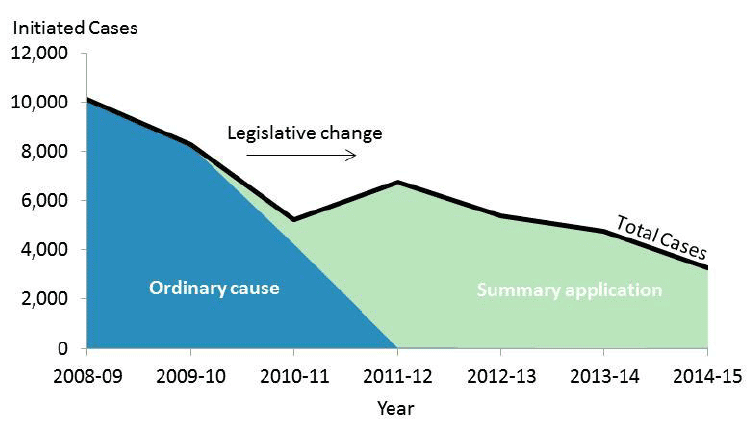Civil justice statistics in Scotland: 2014-2015
The 2014-15 Civil Justice in Scotland release includes: 1. MAIN STATISTICS TABLES (compromising tables that appear in this bulletin) 2. DIVORCE & DISSOLUTION STATISTICS TABLES (further breakdowns on divorce & dissolution) 3. SUPPLEMENTARY STATISTICS TABLES (additional statistics on civil law cases in sheriff courts and the Court of Session) 4. BACKGROUND DATA TABLES (an interactive dataset on civil law court cases by court, that can be used to generate user customised tables and charts)
This document is part of a collection
9. Repossession
Repossession cases initiated was at its lowest since 2008-09
Repossession cases involve default of a mortgage or loan secured on a property
Repossession in Scotland
Repossession cases involve the retaking of property when a borrower is in breach or default of a mortgage or loan secured on the property. It is usually the lender that takes ownership of the property, which is often sold to repay the outstanding mortgage or loan balance. Repossession should not be confused with eviction which, for the purposes of these statistics, refers to the removal of tenants from a rented property.
If the mortgage or secured loan lender has concerns about the level of the arrears, or is not satisfied with the proposals to repay them, they can raise a repossession claim in the courts. This can only happen after the lender has given a calling-up notice and has complied with pre-action requirements. Until recently, repossession cases relating to mortgages and loans were dealt with under ordinary cause procedure. However, the introduction of the Home Owner and Debtor Protection (Scotland) Act 2010 on 30 September 2010 led to these cases being raised as summary applications. Where a repossession case relates to non-residential land or property, the action may be raised either as a summary application or as an ordinary action. Accordingly a number of repossession cases relating to non-residential property or land continue to be raised as ordinary cause.
If successful, the pursuer has the right to take possession of the property. It is important to note that the granting of a repossession case means the court has permitted the repossession to take place, but the order may not be ultimately enforced.
Repossession made up 4 per cent of all civil court cases initiated in 2014-15.
Courts
There were 3,268 repossession cases initiated in 2014-15. This represents a 31 per cent reduction compared to 2013-14 and is 68 per cent lower than the number initiated in 2008-09 (Figure 17). Part of the decrease in 2014-15 may have been due in part to a temporary suspension of repossession cases being taken to court by some lenders whilst a case regarding levels of charges was made against customers with mortgage arrears.
The procedures used to raise repossession cases have been influenced by a number of factors in recent years. As mentioned above, the introduction of the Home Owner and Debtor Protection (Scotland) Act 2010 is the reason for the decrease in ordinary cause cases and the increase in summary applications since 2010-11. An additional factor affecting these statistics was the UK Supreme Court judgment in the RBS v Wilson case on 24 November 2010 which directed that all active mortgage-related repossession cases be withdrawn from the courts and resubmitted as summary applications following a two month waiting period. This resulted in only a small increase in repossession summary applications during 2010-11 followed by a greater increase during 2011-12 (Table 19).
Seventy per cent of repossession summary applications are granted (Table 20).
Figure 17: Repossession cases by procedure

Contact
Email: Eddie Chan
There is a problem
Thanks for your feedback